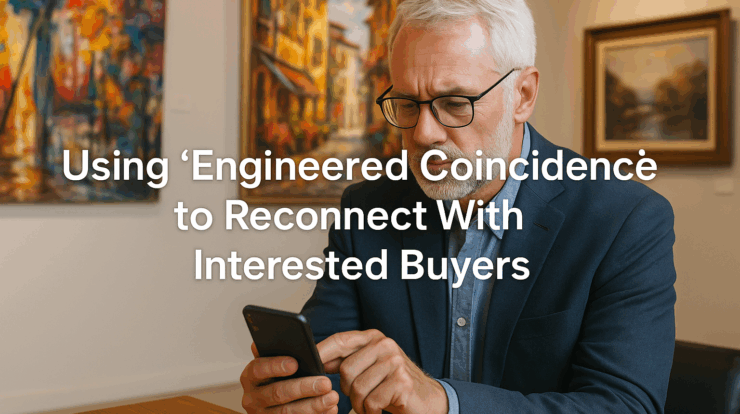
One of the advantages of today’s marketing tools is that they can quietly tell you when someone is taking a closer look at your work. Maybe you’ve sent a newsletter and notice that a certain subscriber has opened it several times. Or you check your website analytics and see that a visitor has viewed the same artwork again and again.
That’s valuable information—but how you use it matters.
The Temptation to Be Too Direct
Not long ago, I heard from an artist who had sent out an email showcasing a new piece. Later, she noticed that one particular subscriber—someone she’d met briefly at an open studio—had clicked through and viewed the painting multiple times.
Her first thought was to send a message saying, “I see you’ve looked at this piece several times…” But she hesitated. That felt too much like surveillance, and she didn’t want to make the collector uncomfortable.
Turning Data Into Opportunity Without Being Creepy
Instead of calling out the tracking data, I suggested a different approach—what I call “engineered coincidence.”
The idea is to create a natural reason to put that specific artwork in front of the buyer again without revealing you’ve been monitoring their activity. For example:
“I like to reach out personally to a few collectors from time to time to share a selection of recent work. I thought you might enjoy seeing these.”
Then, feature the piece they’ve been viewing at the top of that selection. The collector receives a personal touch, the artwork they’ve been drawn to reappears, and the whole interaction feels organic.
Why This Works
-
It builds on existing interest. You’re not introducing something cold—you’re giving them another chance to connect with a piece that’s already caught their eye.
-
It avoids discomfort. The collector doesn’t feel like their online behavior is being monitored.
-
It creates an easy buying opportunity. The follow-up email provides a low-pressure path for them to respond or inquire further.
Make It Part of Your Routine
This kind of outreach shouldn’t be a one-off. Periodically review your email and website analytics, note who’s engaging repeatedly with specific works, and look for ways to reintroduce those pieces naturally. Done regularly, this approach strengthens relationships beyond your standard newsletter and can turn warm interest into actual sales.
The next time your data shows a collector coming back to the same piece, don’t ignore it—and don’t call it out directly. Instead, engineer the coincidence that lets them “discover” it again, right when they might be ready to make a decision.
Engineered Coincidence Follow-Up Email Template
Subject Line Ideas:
-
Thought you might enjoy seeing these
-
A few pieces from my studio this month
-
New works you may like
Body:
Hi [First Name],
From time to time, I like to personally share a few pieces from my studio that I think you might enjoy. This month’s selection includes several recent works I’m especially excited about.
[Insert 3–5 artwork images, with the one you know they’ve shown interest in first.]
Include titles, dimensions, medium, and price under each image.
If one of these pieces catches your eye—or if you’d like more details or additional photos—just reply to this email. I’d be happy to answer questions or arrange a viewing.
Warm regards,
[Your Name]
[Your Website]
[Your Phone Number]
Tips for Best Results:
-
Keep the email personal—send it individually, not through a bulk mailing platform.
-
Use the collector’s first name and keep the tone friendly and conversational.
-
Limit to 3–5 artworks to avoid overwhelming them.
-
Always include the piece they’ve already engaged with at the very top.
-
Follow up again in a few weeks if they open or click but don’t respond.
